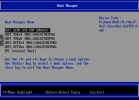so it works now? (i cannot imagine how that works if the config is the same...)
can you maybe post for both the output of
Code:
qm config ID
qm showcmd ID --pretty
?
here it is:
QM CONFIG: VM 201 fails, VM working
root@X:~# qm config 201
agent: 1
bios: ovmf
boot: order=scsi0;sata0;net0
cores: 23
cpu: host
efidisk0: VMPool-1:vm-201-disk-0,efitype=4m,size=1M
hostpci0: 0000:61:00,pcie=1
hostpci1: 0000:64:00,pcie=1
hostpci2: 0000:3e:00,pcie=1
hostpci3: 0000:3f:00,pcie=1
hostpci4: 0000:40:00,pcie=1
hostpci5: 0000:3d:00,pcie=1
hostpci6: 0000:60:00,pcie=1
hostpci7: 0000:41:00,pcie=1
machine: pc-q35-7.1
memory: 102400
meta: creation-qemu=7.1.0,ctime=1675259293
name: MR-RENDER-01
net0: virtio=CA:A1:2E:78:C8:9A,bridge=vmbr0
numa: 1
ostype: win10
sata0: none,media=cdrom
scsi0: VMPool-1:base-100-disk-1/vm-201-disk-1,backup=0,iothread=1,size=640G,ssd=1
scsihw: virtio-scsi-single
smbios1: uuid=fd1635d8-c128-4e34-9766-31fe209e7ca7
sockets: 2
vmgenid: 82330a59-96e5-4757-8283-45449ca2b032
root@X:~# qm config 401
agent: 1
bios: ovmf
boot: order=scsi0;sata0;net0
cores: 23
cpu: host
efidisk0: VMPool-1:vm-401-disk-0,efitype=4m,size=1M
hostpci0: 0000:61:00,pcie=1
hostpci1: 0000:64:00,pcie=1
hostpci2: 0000:3e:00,pcie=1
hostpci3: 0000:3f:00,pcie=1
hostpci4: 0000:40:00,pcie=1
hostpci5: 0000:3d:00,pcie=1
hostpci6: 0000:60:00,pcie=1
hostpci7: 0000:41:00,pcie=1
machine: pc-q35-7.1
memory: 102400
meta: creation-qemu=7.1.0,ctime=1675259293
name: TESTAzken2
net0: virtio=BE:A1:8E:24:1C:9A,bridge=vmbr0
numa: 1
ostype: win10
sata0: none,media=cdrom
scsi0: VMPool-1:vm-401-disk-1,backup=0,iothread=1,size=640G,ssd=1
scsihw: virtio-scsi-single
smbios1: uuid=639e1d34-7f45-45ce-9d18-11f4d3b59987
sockets: 2
vmgenid: 93f39196-8b27-4e86-8593-a378e5307d4a
QM SHOWCMD: VM 201 fails, VM 401 working
root@X:~# qm showcmd 201 --pretty
/usr/bin/kvm \
-id 201 \
-name 'MR-RENDER-01,debug-threads=on' \
-no-shutdown \
-chardev 'socket,id=qmp,path=/var/run/qemu-server/201.qmp,server=on,wait=off' \
-mon 'chardev=qmp,mode=control' \
-chardev 'socket,id=qmp-event,path=/var/run/qmeventd.sock,reconnect=5' \
-mon 'chardev=qmp-event,mode=control' \
-pidfile /var/run/qemu-server/201.pid \
-daemonize \
-smbios 'type=1,uuid=fd1635d8-c128-4e34-9766-31fe209e7ca7' \
-drive 'if=pflash,unit=0,format=raw,readonly=on,file=/usr/share/pve-edk2-firmware//OVMF_CODE_4M.secboot.fd' \
-drive 'if=pflash,unit=1,id=drive-efidisk0,format=raw,file=/dev/zvol/VMPool-1/vm-201-disk-0,size=540672' \
-smp '46,sockets=2,cores=23,maxcpus=46' \
-nodefaults \
-boot 'menu=on,strict=on,reboot-timeout=1000,splash=/usr/share/qemu-server/bootsplash.jpg' \
-vnc 'unix:/var/run/qemu-server/201.vnc,password=on' \
-no-hpet \
-cpu 'host,hv_ipi,hv_relaxed,hv_reset,hv_runtime,hv_spinlocks=0x1fff,hv_stimer,hv_synic,hv_time,hv_vapic,hv_vpindex,+kvm_pv_eoi,+kvm_pv_unhalt' \
-m 102400 \
-object 'memory-backend-ram,id=ram-node0,size=51200M' \
-numa 'node,nodeid=0,cpus=0-22,memdev=ram-node0' \
-object 'memory-backend-ram,id=ram-node1,size=51200M' \
-numa 'node,nodeid=1,cpus=23-45,memdev=ram-node1' \
-object 'iothread,id=iothread-virtioscsi0' \
-readconfig /usr/share/qemu-server/pve-q35-4.0.cfg \
-device 'vmgenid,guid=82330a59-96e5-4757-8283-45449ca2b032' \
-device 'usb-tablet,id=tablet,bus=ehci.0,port=1' \
-device 'vfio-pci,host=0000:61:00.0,id=hostpci0.0,bus=ich9-pcie-port-1,addr=0x0.0,multifunction=on' \
-device 'vfio-pci,host=0000:61:00.1,id=hostpci0.1,bus=ich9-pcie-port-1,addr=0x0.1' \
-device 'vfio-pci,host=0000:61:00.2,id=hostpci0.2,bus=ich9-pcie-port-1,addr=0x0.2' \
-device 'vfio-pci,host=0000:61:00.3,id=hostpci0.3,bus=ich9-pcie-port-1,addr=0x0.3' \
-device 'vfio-pci,host=0000:64:00.0,id=hostpci1.0,bus=ich9-pcie-port-2,addr=0x0.0,multifunction=on' \
-device 'vfio-pci,host=0000:64:00.1,id=hostpci1.1,bus=ich9-pcie-port-2,addr=0x0.1' \
-device 'vfio-pci,host=0000:64:00.2,id=hostpci1.2,bus=ich9-pcie-port-2,addr=0x0.2' \
-device 'vfio-pci,host=0000:64:00.3,id=hostpci1.3,bus=ich9-pcie-port-2,addr=0x0.3' \
-device 'vfio-pci,host=0000:3e:00.0,id=hostpci2.0,bus=ich9-pcie-port-3,addr=0x0.0,multifunction=on' \
-device 'vfio-pci,host=0000:3e:00.1,id=hostpci2.1,bus=ich9-pcie-port-3,addr=0x0.1' \
-device 'vfio-pci,host=0000:3e:00.2,id=hostpci2.2,bus=ich9-pcie-port-3,addr=0x0.2' \
-device 'vfio-pci,host=0000:3e:00.3,id=hostpci2.3,bus=ich9-pcie-port-3,addr=0x0.3' \
-device 'vfio-pci,host=0000:3f:00.0,id=hostpci3.0,bus=ich9-pcie-port-4,addr=0x0.0,multifunction=on' \
-device 'vfio-pci,host=0000:3f:00.1,id=hostpci3.1,bus=ich9-pcie-port-4,addr=0x0.1' \
-device 'vfio-pci,host=0000:3f:00.2,id=hostpci3.2,bus=ich9-pcie-port-4,addr=0x0.2' \
-device 'vfio-pci,host=0000:3f:00.3,id=hostpci3.3,bus=ich9-pcie-port-4,addr=0x0.3' \
-device 'pcie-root-port,id=ich9-pcie-port-5,addr=10.0,x-speed=16,x-width=32,multifunction=on,bus=pcie.0,port=5,chassis=5' \
-device 'vfio-pci,host=0000:40:00.0,id=hostpci4.0,bus=ich9-pcie-port-5,addr=0x0.0,multifunction=on' \
-device 'vfio-pci,host=0000:40:00.1,id=hostpci4.1,bus=ich9-pcie-port-5,addr=0x0.1' \
-device 'vfio-pci,host=0000:40:00.2,id=hostpci4.2,bus=ich9-pcie-port-5,addr=0x0.2' \
-device 'vfio-pci,host=0000:40:00.3,id=hostpci4.3,bus=ich9-pcie-port-5,addr=0x0.3' \
-device 'pcie-root-port,id=ich9-pcie-port-6,addr=10.1,x-speed=16,x-width=32,multifunction=on,bus=pcie.0,port=6,chassis=6' \
-device 'vfio-pci,host=0000:3d:00.0,id=hostpci5.0,bus=ich9-pcie-port-6,addr=0x0.0,multifunction=on' \
-device 'vfio-pci,host=0000:3d:00.1,id=hostpci5.1,bus=ich9-pcie-port-6,addr=0x0.1' \
-device 'vfio-pci,host=0000:3d:00.2,id=hostpci5.2,bus=ich9-pcie-port-6,addr=0x0.2' \
-device 'vfio-pci,host=0000:3d:00.3,id=hostpci5.3,bus=ich9-pcie-port-6,addr=0x0.3' \
-device 'pcie-root-port,id=ich9-pcie-port-7,addr=10.2,x-speed=16,x-width=32,multifunction=on,bus=pcie.0,port=7,chassis=7' \
-device 'vfio-pci,host=0000:41:00.0,id=hostpci6.0,bus=ich9-pcie-port-7,addr=0x0.0,multifunction=on' \
-device 'vfio-pci,host=0000:41:00.1,id=hostpci6.1,bus=ich9-pcie-port-7,addr=0x0.1' \
-device 'vfio-pci,host=0000:41:00.2,id=hostpci6.2,bus=ich9-pcie-port-7,addr=0x0.2' \
-device 'vfio-pci,host=0000:41:00.3,id=hostpci6.3,bus=ich9-pcie-port-7,addr=0x0.3' \
-device 'pcie-root-port,id=ich9-pcie-port-8,addr=10.3,x-speed=16,x-width=32,multifunction=on,bus=pcie.0,port=8,chassis=8' \
-device 'vfio-pci,host=0000:60:00.0,id=hostpci7.0,bus=ich9-pcie-port-8,addr=0x0.0,multifunction=on' \
-device 'vfio-pci,host=0000:60:00.1,id=hostpci7.1,bus=ich9-pcie-port-8,addr=0x0.1' \
-device 'vfio-pci,host=0000:60:00.2,id=hostpci7.2,bus=ich9-pcie-port-8,addr=0x0.2' \
-device 'vfio-pci,host=0000:60:00.3,id=hostpci7.3,bus=ich9-pcie-port-8,addr=0x0.3' \
-device 'VGA,id=vga,bus=pcie.0,addr=0x1' \
-chardev 'socket,path=/var/run/qemu-server/201.qga,server=on,wait=off,id=qga0' \
-device 'virtio-serial,id=qga0,bus=pci.0,addr=0x8' \
-device 'virtserialport,chardev=qga0,name=org.qemu.guest_agent.0' \
-device 'virtio-balloon-pci,id=balloon0,bus=pci.0,addr=0x3,free-page-reporting=on' \
-iscsi 'initiator-name=iqn.1993-08.org.debian:01:a8866e362c9' \
-device 'virtio-scsi-pci,id=virtioscsi0,bus=pci.3,addr=0x1,iothread=iothread-virtioscsi0' \
-drive 'file=/dev/zvol/VMPool-1/vm-201-disk-1,if=none,id=drive-scsi0,format=raw,cache=none,aio=io_uring,detect-zeroes=on' \
-device 'scsi-hd,bus=virtioscsi0.0,channel=0,scsi-id=0,lun=0,drive=drive-scsi0,id=scsi0,rotation_rate=1,bootindex=100' \
-device 'ahci,id=ahci0,multifunction=on,bus=pci.0,addr=0x7' \
-drive 'if=none,id=drive-sata0,media=cdrom,aio=io_uring' \
-device 'ide-cd,bus=ahci0.0,drive=drive-sata0,id=sata0,bootindex=101' \
-netdev 'type=tap,id=net0,ifname=tap201i0,script=/var/lib/qemu-server/pve-bridge,downscript=/var/lib/qemu-server/pve-bridgedown,vhost=on' \
-device 'virtio-net-pci,mac=CA:A1:2E:78:C8:9A,netdev=net0,bus=pci.0,addr=0x12,id=net0,rx_queue_size=1024,tx_queue_size=1024,bootindex=102' \
-rtc 'driftfix=slew,base=localtime' \
-machine 'type=pc-q35-7.1+pve0' \
-global 'kvm-pit.lost_tick_policy=discard'
root@X:~# qm showcmd 401 --pretty
/usr/bin/kvm \
-id 401 \
-name 'TESTAzken2,debug-threads=on' \
-no-shutdown \
-chardev 'socket,id=qmp,path=/var/run/qemu-server/401.qmp,server=on,wait=off' \
-mon 'chardev=qmp,mode=control' \
-chardev 'socket,id=qmp-event,path=/var/run/qmeventd.sock,reconnect=5' \
-mon 'chardev=qmp-event,mode=control' \
-pidfile /var/run/qemu-server/401.pid \
-daemonize \
-smbios 'type=1,uuid=639e1d34-7f45-45ce-9d18-11f4d3b59987' \
-drive 'if=pflash,unit=0,format=raw,readonly=on,file=/usr/share/pve-edk2-firmware//OVMF_CODE_4M.secboot.fd' \
-drive 'if=pflash,unit=1,id=drive-efidisk0,format=raw,file=/dev/zvol/VMPool-1/vm-401-disk-0,size=540672' \
-smp '46,sockets=2,cores=23,maxcpus=46' \
-nodefaults \
-boot 'menu=on,strict=on,reboot-timeout=1000,splash=/usr/share/qemu-server/bootsplash.jpg' \
-vnc 'unix:/var/run/qemu-server/401.vnc,password=on' \
-no-hpet \
-cpu 'host,hv_ipi,hv_relaxed,hv_reset,hv_runtime,hv_spinlocks=0x1fff,hv_stimer,hv_synic,hv_time,hv_vapic,hv_vpindex,+kvm_pv_eoi,+kvm_pv_unhalt' \
-m 102400 \
-object 'memory-backend-ram,id=ram-node0,size=51200M' \
-numa 'node,nodeid=0,cpus=0-22,memdev=ram-node0' \
-object 'memory-backend-ram,id=ram-node1,size=51200M' \
-numa 'node,nodeid=1,cpus=23-45,memdev=ram-node1' \
-object 'iothread,id=iothread-virtioscsi0' \
-readconfig /usr/share/qemu-server/pve-q35-4.0.cfg \
-device 'vmgenid,guid=93f39196-8b27-4e86-8593-a378e5307d4a' \
-device 'usb-tablet,id=tablet,bus=ehci.0,port=1' \
-device 'vfio-pci,host=0000:61:00.0,id=hostpci0.0,bus=ich9-pcie-port-1,addr=0x0.0,multifunction=on' \
-device 'vfio-pci,host=0000:61:00.1,id=hostpci0.1,bus=ich9-pcie-port-1,addr=0x0.1' \
-device 'vfio-pci,host=0000:61:00.2,id=hostpci0.2,bus=ich9-pcie-port-1,addr=0x0.2' \
-device 'vfio-pci,host=0000:61:00.3,id=hostpci0.3,bus=ich9-pcie-port-1,addr=0x0.3' \
-device 'vfio-pci,host=0000:64:00.0,id=hostpci1.0,bus=ich9-pcie-port-2,addr=0x0.0,multifunction=on' \
-device 'vfio-pci,host=0000:64:00.1,id=hostpci1.1,bus=ich9-pcie-port-2,addr=0x0.1' \
-device 'vfio-pci,host=0000:64:00.2,id=hostpci1.2,bus=ich9-pcie-port-2,addr=0x0.2' \
-device 'vfio-pci,host=0000:64:00.3,id=hostpci1.3,bus=ich9-pcie-port-2,addr=0x0.3' \
-device 'vfio-pci,host=0000:3e:00.0,id=hostpci2.0,bus=ich9-pcie-port-3,addr=0x0.0,multifunction=on' \
-device 'vfio-pci,host=0000:3e:00.1,id=hostpci2.1,bus=ich9-pcie-port-3,addr=0x0.1' \
-device 'vfio-pci,host=0000:3e:00.2,id=hostpci2.2,bus=ich9-pcie-port-3,addr=0x0.2' \
-device 'vfio-pci,host=0000:3e:00.3,id=hostpci2.3,bus=ich9-pcie-port-3,addr=0x0.3' \
-device 'vfio-pci,host=0000:3f:00.0,id=hostpci3.0,bus=ich9-pcie-port-4,addr=0x0.0,multifunction=on' \
-device 'vfio-pci,host=0000:3f:00.1,id=hostpci3.1,bus=ich9-pcie-port-4,addr=0x0.1' \
-device 'vfio-pci,host=0000:3f:00.2,id=hostpci3.2,bus=ich9-pcie-port-4,addr=0x0.2' \
-device 'vfio-pci,host=0000:3f:00.3,id=hostpci3.3,bus=ich9-pcie-port-4,addr=0x0.3' \
-device 'pcie-root-port,id=ich9-pcie-port-5,addr=10.0,x-speed=16,x-width=32,multifunction=on,bus=pcie.0,port=5,chassis=5' \
-device 'vfio-pci,host=0000:40:00.0,id=hostpci4.0,bus=ich9-pcie-port-5,addr=0x0.0,multifunction=on' \
-device 'vfio-pci,host=0000:40:00.1,id=hostpci4.1,bus=ich9-pcie-port-5,addr=0x0.1' \
-device 'vfio-pci,host=0000:40:00.2,id=hostpci4.2,bus=ich9-pcie-port-5,addr=0x0.2' \
-device 'vfio-pci,host=0000:40:00.3,id=hostpci4.3,bus=ich9-pcie-port-5,addr=0x0.3' \
-device 'pcie-root-port,id=ich9-pcie-port-6,addr=10.1,x-speed=16,x-width=32,multifunction=on,bus=pcie.0,port=6,chassis=6' \
-device 'vfio-pci,host=0000:3d:00.0,id=hostpci5.0,bus=ich9-pcie-port-6,addr=0x0.0,multifunction=on' \
-device 'vfio-pci,host=0000:3d:00.1,id=hostpci5.1,bus=ich9-pcie-port-6,addr=0x0.1' \
-device 'vfio-pci,host=0000:3d:00.2,id=hostpci5.2,bus=ich9-pcie-port-6,addr=0x0.2' \
-device 'vfio-pci,host=0000:3d:00.3,id=hostpci5.3,bus=ich9-pcie-port-6,addr=0x0.3' \
-device 'pcie-root-port,id=ich9-pcie-port-7,addr=10.2,x-speed=16,x-width=32,multifunction=on,bus=pcie.0,port=7,chassis=7' \
-device 'vfio-pci,host=0000:60:00.0,id=hostpci6.0,bus=ich9-pcie-port-7,addr=0x0.0,multifunction=on' \
-device 'vfio-pci,host=0000:60:00.1,id=hostpci6.1,bus=ich9-pcie-port-7,addr=0x0.1' \
-device 'vfio-pci,host=0000:60:00.2,id=hostpci6.2,bus=ich9-pcie-port-7,addr=0x0.2' \
-device 'vfio-pci,host=0000:60:00.3,id=hostpci6.3,bus=ich9-pcie-port-7,addr=0x0.3' \
-device 'pcie-root-port,id=ich9-pcie-port-8,addr=10.3,x-speed=16,x-width=32,multifunction=on,bus=pcie.0,port=8,chassis=8' \
-device 'vfio-pci,host=0000:41:00.0,id=hostpci7.0,bus=ich9-pcie-port-8,addr=0x0.0,multifunction=on' \
-device 'vfio-pci,host=0000:41:00.1,id=hostpci7.1,bus=ich9-pcie-port-8,addr=0x0.1' \
-device 'vfio-pci,host=0000:41:00.2,id=hostpci7.2,bus=ich9-pcie-port-8,addr=0x0.2' \
-device 'vfio-pci,host=0000:41:00.3,id=hostpci7.3,bus=ich9-pcie-port-8,addr=0x0.3' \
-device 'VGA,id=vga,bus=pcie.0,addr=0x1' \
-chardev 'socket,path=/var/run/qemu-server/401.qga,server=on,wait=off,id=qga0' \
-device 'virtio-serial,id=qga0,bus=pci.0,addr=0x8' \
-device 'virtserialport,chardev=qga0,name=org.qemu.guest_agent.0' \
-device 'virtio-balloon-pci,id=balloon0,bus=pci.0,addr=0x3,free-page-reporting=on' \
-iscsi 'initiator-name=iqn.1993-08.org.debian:01:a8866e362c9' \
-device 'virtio-scsi-pci,id=virtioscsi0,bus=pci.3,addr=0x1,iothread=iothread-virtioscsi0' \
-drive 'file=/dev/zvol/VMPool-1/vm-401-disk-1,if=none,id=drive-scsi0,format=raw,cache=none,aio=io_uring,detect-zeroes=on' \
-device 'scsi-hd,bus=virtioscsi0.0,channel=0,scsi-id=0,lun=0,drive=drive-scsi0,id=scsi0,rotation_rate=1,bootindex=100' \
-device 'ahci,id=ahci0,multifunction=on,bus=pci.0,addr=0x7' \
-drive 'if=none,id=drive-sata0,media=cdrom,aio=io_uring' \
-device 'ide-cd,bus=ahci0.0,drive=drive-sata0,id=sata0,bootindex=101' \
-netdev 'type=tap,id=net0,ifname=tap401i0,script=/var/lib/qemu-server/pve-bridge,downscript=/var/lib/qemu-server/pve-bridgedown,vhost=on' \
-device 'virtio-net-pci,mac=BE:A1:8E:24:1C:9A,netdev=net0,bus=pci.0,addr=0x12,id=net0,rx_queue_size=1024,tx_queue_size=1024,bootindex=102' \
-rtc 'driftfix=slew,base=localtime' \
-machine 'type=pc-q35-7.1+pve0' \
-global 'kvm-pit.lost_tick_policy=discard'



